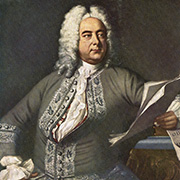A contemporary regarded Handel’s opera “Berenice” as just a patchwork, but it has many little gems to offer. In May “Berenice” will be performed again on the operatic stage in Halle.
When the curtain rises on 25 May 2018 in the Halle Opera for the inaugural performance of the first production of Handel’s Berenice, Regina d‘Egitto using the new score of the Halle Handel Edition, then all Handel’s surviving operas will have been staged in new productions in Halle. Halle is thus the first city worldwide which will be able to boast of such an achievement in its productions.
The fact that Berenice comes at the end of the series may be coincidence, but it is not entirely without reason: Handel’s opera, premiered on 18 May 1737 in the Covent Garden Theatre London, is one of the composer’s less well-known works and was extensively criticised in the past. Winton Dean regarded the libretto as a “botched piece of work”, a patchwork in which one improbable stage situation was followed by the next. The poet of the original libretto was no stranger: Antonio Salvi wrote Berenice in 1709 for the Medici Theatre in Pratolino; Handel used his texts in a total of seven operas, including Rodelinda of 1725 and Ariodante of 1734.
Salvi’s text was characterised by a certain disjointedness even in the original, and the London adaptation, in which the recitatives were subject to extreme cuts, makes the intrigue between two major powers – Rome and Pontus – over supremacy in Egypt and thus for the hand of the Queen Berenice III (d. 80 BC) additionally unclear. Nevertheless the libretto cannot be criticised for logical inconsistences; it offers an extremely condensed and intense didactic Baroque play on the “Gare di Politica e d’Amor” listed in the final chorus, the conflicts between politics and love.
A contemporary of Handel’s, the Earl of Shaftesbury, attended a rehearsal of the “charming Berenice” on 12 May 1737, from which he drew “inexpressible delight”. In his account the Earl expressed the opinion that the three acts of the opera had different degrees of significance: the first being “mostly in the agreable strain”, the second “more in the great taste” and the third a mixture of “great & pleasing”. He therefore saw in Berenice a mixture between a middle and the high style. In fact it can be shown that in the course of working on the opera, Handel intentionally removed elements of pathos or reduced them, in order to replace them with more pleasant and cheerful emotions.
In this framework of a light, “middle” opera, Berenice offers musical treasures in great abundance: the second movement of the overture became famous as the “Minuet from Berenice”, and also famous is Berenice’s extended aria in the third act, in which she reflects on the inconstancy of the God Amor in duet with the solo oboist (then Giuseppe Sammartini); the musical imagery which Handel incorporated is enchanting, such as the imitation of humming bees in Fabio’s “Vedi l’ape” and the sad cooing of a dove in Selene’s “Tortorella che rimira”.
The pre-publication score from the Halle Handel Edition contains the musical text of the first performance of May 1737. The complete volume planned for 2019 will also contain the numbers which Handel took out or shortened in advance of the first performance.
Wolfgang Hirschmann
(from [t]akte 1/2018)



